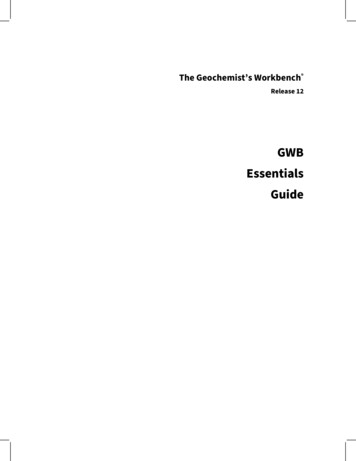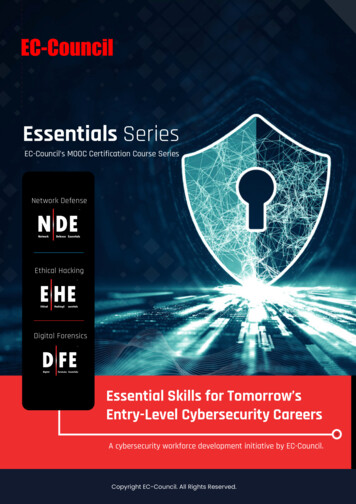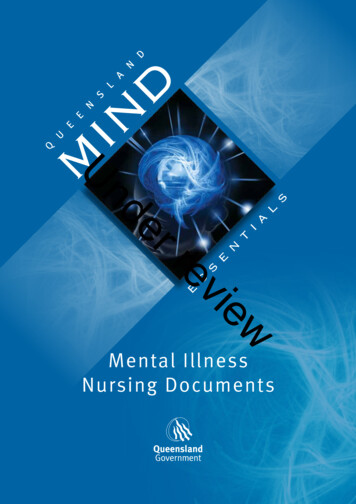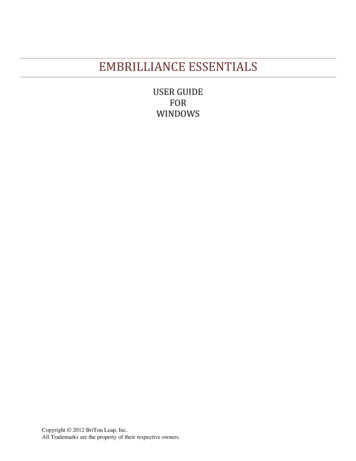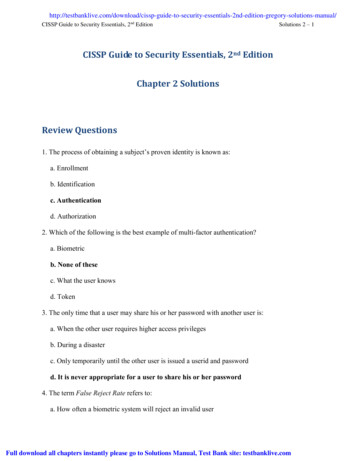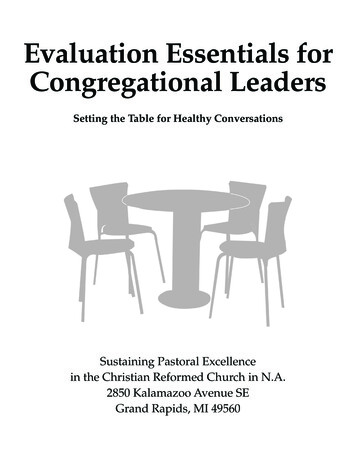
Transcription
Evaluation Essentials forCongregational LeadersSetting the Table for Healthy ConversationsSustaining Pastoral Excellencein the Christian Reformed Church in N.A.2850 Kalamazoo Avenue SEGrand Rapids, MI 49560
Evaluation Essentials forCongregational LeadersSetting the Table for Healthy ConversationsGrand Rapids, MI 49560
Unless otherwise noted, Scripture quotations in this publication are from the Holy Bible, Today’sNew International Version (TNIV), 2001, 2005, International Bible Society. All rights reservedworldwide. 2010 by the Sustaining Pastoral Excellence initiative of the Christian Reformed Church in NorthAmerica, 2850 Kalamazoo Ave. SE, Grand Rapids, MI 49560. All rights reserved. With the exceptionof brief excerpts for review purposes, no part of this book may be reproduced in any mannerwhatsoever without written permission from the publisher. Printed in the United States of America.We welcome your comments.Call us at the Office of Pastor-Church Relations: 616-224-0837 or toll free 877-279-9994Email us at: Norm Thomasma, director – nthomasma@crcna.orgCecil Van Niejenhuis, pastor/congregation consultant – cvanniejenhuis@crcna.orgJeanne Kallemeyn, staff ministry specialist – ch index.cfm
Table of ContentsMany Voices, Messages, and Perspectives. . . . . . . . . . . . . . . . . . . . . . . . . . . . . . . . . . . . . . . . 5How to Use This Training Tool. . . . . . . . . . . . . . . . . . . . . . . . . . . . . . . . . . . . . . . . . . . . . . . . . 7Collaborators . . . . . . . . . . . . . . . . . . . . . . . . . . . . . . . . . . . . . . . . . . . . . . . . . . . . . . . . . . . . . 7Introduction . . . . . . . . . . . . . . . . . . . . . . . . . . . . . . . . . . . . . . . . . . . . . . . . . . . . . . . . . . . . 9Chapter 1—The Church and Evaluation of Paid Personnel. . . . . . . . . . . . . . . . . . . . 13A. The Biblical Basis. . . . . . . . . . . . . . . . . . . . . . . . . . . . . . . . . . . . . . . . . . . . . . . . . . . . . . 13B. The Wisdom of the Years . . . . . . . . . . . . . . . . . . . . . . . . . . . . . . . . . . . . . . . . . . . . . . . 15C. Recognizing the Times. . . . . . . . . . . . . . . . . . . . . . . . . . . . . . . . . . . . . . . . . . . . . . . . . 17Chapter 2—Key Questions. . . . . . . . . . . . . . . . . . . . . . . . . . . . . . . . . . . . . . . . . . . . . . . . 21A. The “Why?” of Evaluation. . . . . . . . . . . . . . . . . . . . . . . . . . . . . . . . . . . . . . . . . . . . . . . 21B. The “When?” of Evaluation. . . . . . . . . . . . . . . . . . . . . . . . . . . . . . . . . . . . . . . . . . . . . . 22C. The “Where?” of Evaluation. . . . . . . . . . . . . . . . . . . . . . . . . . . . . . . . . . . . . . . . . . . . . 27D. The “Who?” of Evaluation. . . . . . . . . . . . . . . . . . . . . . . . . . . . . . . . . . . . . . . . . . . . . . . 31E. The “What?” of Evaluation. . . . . . . . . . . . . . . . . . . . . . . . . . . . . . . . . . . . . . . . . . . . . . 34Chapter 3—The “How?” of Evaluation. . . . . . . . . . . . . . . . . . . . . . . . . . . . . . . . . . . . . 37Step 1: Getting Started. . . . . . . . . . . . . . . . . . . . . . . . . . . . . . . . . . . . . . . . . . . . . . . . . . . 37Step 2: Planning the Process. . . . . . . . . . . . . . . . . . . . . . . . . . . . . . . . . . . . . . . . . . . . . . . 38Step 3: What to Do with the Results . . . . . . . . . . . . . . . . . . . . . . . . . . . . . . . . . . . . . . . . . 38Step 4: Evaluating the Process. . . . . . . . . . . . . . . . . . . . . . . . . . . . . . . . . . . . . . . . . . . . . . 39A Final Word. . . . . . . . . . . . . . . . . . . . . . . . . . . . . . . . . . . . . . . . . . . . . . . . . . . . . . . . . . . 40AppendicesA: A Personnel Committee in the Local Congregation. . . . . . . . . . . . . . . . . . . . . . . . . . . . 41B: Understanding Poorly Differentiated Church Members and Pastors. . . . . . . . . . . . . . . . 46C: Staff Self-Evaluation . . . . . . . . . . . . . . . . . . . . . . . . . . . . . . . . . . . . . . . . . . . . . . . . . . . 47D: Broad-Based Survey . . . . . . . . . . . . . . . . . . . . . . . . . . . . . . . . . . . . . . . . . . . . . . . . . . . 48E: Crucial Areas of Ministry Survey. . . . . . . . . . . . . . . . . . . . . . . . . . . . . . . . . . . . . . . . . . 51F: Relationship-Based Tool . . . . . . . . . . . . . . . . . . . . . . . . . . . . . . . . . . . . . . . . . . . . . . . . 55G: Pastor’s Priorities Evaluation . . . . . . . . . . . . . . . . . . . . . . . . . . . . . . . . . . . . . . . . . . . . . 56H: Job Description-Based Tool. . . . . . . . . . . . . . . . . . . . . . . . . . . . . . . . . . . . . . . . . . . . . . 58Annotated Bibliography. . . . . . . . . . . . . . . . . . . . . . . . . . . . . . . . . . . . . . . . . . . . . . . . . 613
Evaluating pastors is simple / impossible / . . . .He couldn’t administer his way out of a paper bag.rsotsapluatevaenacastorsOnly pThe job description is . . . .keyworthlessa pretty thoughtall of the aboveIt’s as easy as riding a bike . . . . . across Niagara Falls.!edfgnisuI’m jbetotn4
Many voices, messages, and perspectivescome into play in evaluating pastors and/or church staff.And there may well be no “right” answers. But there are helpfulpractices born of thoughtful deliberation. This training tool isintended to help church leaders have a fruitful conversation aboutevaluation in their local setting—and to strengthen the local churchby blessing its staff with timely, effective feedback.The children’s ministry coordinator is so caring.She just needs thicker skin.Why are youevaluating thepastornow?Let’s get Mikey to evaluate the youthminister. He’ll do anything!5
How to Use This Training ToolThe format of this training tool has been intentionally designed for you, the reader. Our desire is foryou to move from reading to understanding, to doing. The subtitle, “setting the table for healthyconversations,” aims to help you visualize setting the table in a way that fits your specific situation.Thus many of the graphics in this booklet suggest a table-setting theme. The side of each page offersyou a place to make notes as you read, and it often includes comments or questions to help bring outa response or thought. Our intent is that this training tool produces rich conversation, similar to whathappens in the best gatherings of family and friends. And, as in any such gathering, we both seek andacknowledge the guiding presence of God.CollaboratorsThis training tool is a publication of the Sustaining Pastoral Excellence (SPE) initiative of the ChristianReformed Church in North America (CRCNA). The people responsible for putting together thisbooklet are staff of the Office of Pastor-Church Relations: Rev. Norm Thomasma, Rev. Cecil VanNiejenhuis, and Mrs. Jeanne Kallemeyn. They were assisted by an SPE peer learning group ofwhich Norm and Cecil are members. The other members are Rev. Jim Pot, pastor of Bethel CRC inWaterdown, Ont.; Rev. John Terpstra, pastor of Immanuel CRC in Fort Collins, Colo.; and Rev. MarkVermaire, pastor of Crossroads CRC in San Marcos, Calif. SPE’s Lilly Implementation Team also gavevaluable input.7
IntroductionHow Should We Evaluate Ministry Staff?Evaluation is a familiar word to many North Americans. But whatit means varies from the business world, to the academy, to thetrades, and, certainly, to the church. In fact, many of the evaluationpractices in vogue within our culture do not easily translate intothe life of congregations. Nor should they. Some sorting out needsto happen. An uncritical importing of business practices in theprocess of evaluation can have a significant negative impact.Still, congregations have learned from their members’ valuableexperiences in the business and working world. We live in aworld that belongs entirely to God, and our Reformed theologicaltradition is hospitable to the knowledge and wisdom gained fromthe many arenas in which Christians interact with the world.However, the church has its own unique character, and evaluatingministry staff has its own unique challenges.Lyle Schaller, a sage of congregational life in North America, isquoted as say ing that “90% of what pastors do is invisible to 90%of the congregation 90% of the time.” The dynamics for churchstaff are often similar. Additionally we need to ask about theorigin and nature of the church as opposed to a business. Unlikea business, the church is described as “the body of Christ” and“the family of God.” Within a congregation, relationships takeprecedence over a “bottom line” of strictly financial concerns.Importing business practices carte blanche can erode the essentialcharacter of the church. Consider the following from Roy Oswald,senior consultant for Alban Institute, in regard to assessing clergy:Clergy assessment is one area where we at the Alban Institutebelieve secular technologies do not belong. Congregational memberswith confidence in their evaluative skills may volunteer to set upprocesses for the assessment of their pastors. They may then proceedto objectify the roles and functions of clergy on the assumption that9What does the word“evaluation” mean to you?What unique challengesmight the church have inevaluating church staff?Do you agree with LyleSchaller? Why or why not?
these factors are quantifiable. But how do you measure the quality ofan interaction between a pastor and a parishioner?Many such assessments oversimplify the pastoral role. I do notbelieve that a quantifiable assessment can ever get at the essence ofthat role. . . .We think Oswald’s statementhas some bearing on theevaluation of church staff aswell. What do you think?What would a gracious,candid, ongoing conversationlook like to you?. . . The Alban Institute constantly receives calls and lettersrequesting forms and procedures for clergy assessment. To date wehave resisted putting into print one recommended process. . . .—Getting a Fix on Your Ministry, p. 4Oswald recognizes the intensely relational element of work withina congregation. “Productivity” is less about work accomplished(though it is important that work is accomplished) and moreabout the quality of the community in which Christ has firstplace, where courageous love finds expression, and where thestewardship of gifts is understood as a grateful response toGod’s gracious, creative call. With this in mind we suggest thathelpful evaluations within congregational life involve a gracious,candid, ongoing conversation. (By candid here we mean “sincerelyopen and honest.”) Many variables must be accounted for if thisconversation is to happen. What follows are perspectives andguidelines to improve the likelihood of this happening well.Though it’s not the final word on evaluation, we hope it is ahelpful word.Note: Most conversations about evaluation relate to people whoare paid for their work within the congregation. This training toolfocuses primarily but not exclusively on paid congregational staff.What are some “bestpractices” you can adapt toyour context?An Invitation: Adapt Current “Best Practices” toYour ContextThe CRCNA is now a diverse family of congregations drawingfrom a rich variety of cultures and traditions. Each congregationis prompted to develop culturally relevant ways in which theleaders of the church experience a vital “feedback loop” withintheir context. This may involve wise counsel from senior leadersof the church, intentional conversations with select individualsand groups, or other creative efforts to ensure that leaders gaina sense of the effectiveness of their work and of the impact theyare having on the people they serve. In short, in every contextthere is significant value in finding ways to have gracious, candid,ongoing conversations.10
Comparing Terms: Evaluation and AssessmentIn some circles the terms evaluation and assessment are seen asidentifying a similar or identical function. (The preceding quotefrom the Alban Institute is an example.) In this training toolevaluation and assessment are seen as quite different. Evaluationhas to do with a person’s performance, attitude, productivity,relationships, and other dimensions of how that person is doing ina particular role.Assessment has more to do with a person’s make-up, capacity,temperament, and wiring. It is directed more toward determininga person’s fit and capacity for a given role rather than a person’sperformance at a certain time and place. Generally assessment hasmore to do with determining a vocational call and understandingthe level of fit an individual will have or does have in a given role.Evaluation and assessment are related. For example, a personwhose performance in a role is considered exemplary wouldlikely be assessed as a good fit for that role. On the other hand, ifa person’s evaluation repeatedly indicates deficits, an assessmentmay be in order to determine the person’s fit for that role.11Does this comparison ofevaluation and assessmentsound right to you? Explain.
Chapter 1The Church And Evaluation Of Paid PersonnelA. The Biblical BasisThe Gifts of God for the People of GodEvaluations find their place within the context of our deepestand richest spiritual desire: to honor and bless the God who isFather, Son, and Holy Spirit! We are “fearfully and wonderfullymade” (Ps. 139:14)—gifted by God for service! (See 1 Cor. 12.)As Paul says in Romans 12:5, “each member belongs to all theothers.” And then in Romans 12:7-8 Paul says that “if your giftis to lead, do it diligently.” Evaluation is about encouragingand ensuring that leadership gifts are being exercised faithfullyand fruitfully. Because we belong to each other, we have reasonand responsibility to hold each other accountable! And becausewe belong to our faithful God, we are accountable together, toour Lord!Leadership and servicein the church are greatresponsibilities. How canwe know when someone isleading and serving well?The Gifts of God for the Mission of GodAccountability is an essential aspect of knowing ourselves to bealive by the grace and power of the living God. All that we areand all that we have belong to our Lord. And, as Jesus made clearwhen he told the parable of the talents (Matt. 25:14-30), God givestalents and expects that we will use them faithfully. There is botha promise of fruitfulness and the certainty of accountability. Thisis not intended to inject our lives with fear, but—as the writer ofEcclesiastes makes clear—accountability is intended to infuse allof our activities with meaning! (See Ecclesiastes 12:13-14.)Evaluations are part and parcel of the longing shared by everybeliever and every believing community: to use the resources Godgives as wisely and as fully as possible in the work of his comingkingdom. The stories of our lives and our communities find theirmeaning and purpose within the contours of the great story of13How can evaluations help usserve faithfully?
Scripture—that story in which God makes his appeal to the worldthrough us. So the ongoing question is “How are we doing?”Shaped as a Covenant EnterpriseIn what ways arerelationships andresponsibilities in yourchurch shaped by a sense ofcovenant?There’s an Old Testament story that gives us a helpful point ofreference when we consider the relationship between pastors,staff, and the church. Do you remember Boaz? The story tells usthat when Boaz arrived in his fields, he greeted the harvestersby saying, “The Lord be with you!” And they called back, “TheLord bless you!” (Ruth 2:4). Here is a model relationship that is somuch more than merely that of an employer and employees. It’sa relationship that speaks of more than mere contract—it speaksof covenant.Covenants are relationships built on promises and enrichedby trust. They are relationships tilted toward the flourishing ofthe other and anchored in mutual respect and unconditionallove. Contracts are business relationships in which services arepurchased and renewal is conditional upon customer satisfaction.Contracts do not have much room for grace. Covenants do.What are some examples ofcontractual relationships inyour church? Are they framedwithin a sense of covenant?Explain.A healthy concept of employer-employee relationships inthe church recognizes legitimate contractual elements andintentionally sets them within the framework of a covenantalrelationship. Undertaking an evaluation as simply a matter ofmeeting measurable goals and performance standards reducesthe council to the role of employer and the role of ordained andun-ordained personnel to that of employee. But in the church therelationship is much more than that—it is also and more deeplya relationship of brothers and sisters in Christ, God’s family, andpartners in the gospel—all of whom are called to use their gifts inthe service of God.Leadership in a Covenant CommunityWhat qualities do you thinkmake for effective leadership?This covenantal framework is exemplified in a previous trainingtool, Effective Leadership in the Church. That tool emphasizes thatin the faith community effective leadership involves qualities inrelationship rather than traits of an individual. These qualities arecharacter, conviction, competence, and confluence—all of which, whenpresent in the leader, inspire reciprocal qualities in those whofollow. Note the following paragraph from Effective Leadership inthe Church (p. 20):14
Four factors (the four “Cs”) seem ever-present in situations ofeffective leadership: Character in the leader (which generates trust in thefollowers). Conviction in the leader (which helps the congregationdiscern its purpose and vision). Competencies in the leader (which help a congregationfunction as a healthy system—i.e., deal with the normalanxieties and conflicts of communal life in healthy andproductive ways).Are there other factors youmight add here? Explain. Confluence of leader, congregation, time, place, ministry,opportunity, and resources—all as gifts of God’s Spiritenabling a leader and congregation to work joyfullytogether in realizing God’s purposes.(Note: We encourage you to read Effective Leadership in the Churchas you consider the evaluation of your pastor or church staff.Free copies are available from Faith Alive Christian Resources800-333-8300.)Effective evaluation practices honor the relational dynamic ofleadership. At a minimum, wise evaluation practices requirebuy-in from those being evaluated and those administering theprocess. The most helpful evaluations are those welcomed, or eveninitiated, by the persons being evaluated.How does this discussionmesh with the idea of agracious, candid, ongoingconversation?B. The Wisdom of the YearsWhat Does the Church Order Say?Regular evaluation is a normal and healthy way of experiencingcommunity within the church of Jesus. This is true for pastors, forelders and deacons, and also for councils. The willingness to engage,consider, and submit to the judgments of others is a part of the humilitywith which leaders are clothed.Pastors are accountable to their calling church in matters ofdoctrine, life, and duty (Church Order, Art. 131). In instances ofemployment outside a parish setting (for example, chaplaincy),this accountability may need to be shared in some fashion.Note also that pastors are accountable to the council (elders anddeacons together) and not only to the body of elders. If a church1The Church Order is specific to the CRCNA. See bibliography for more information.15What practices ofaccountability are you familiarwith in your church?
establishes a personnel committee (as described in Appendix A,p. 41), it is important that the council retain its “original authority”for the leadership of the church and the supervision of theordained staff.Give an example of howmutual censure has benefitedyour council and church.In what ways have churchvisitors helped yourcongregation stay healthy?Elders and deacons are to hold each other accountable by wayof a traditional practice called “mutual censure” (Art. 36). Thisis intended to be a rich experience of candid conversation andevaluation in which elders and deacons together ask themselves,“How are we doing? What are we doing that we should continuedoing? What are we not doing that we might consider doing?What are we doing that we should decrease, or stop?” Notethat this kind of healthy conversation surrounding matters ofaccountability is prescribed a minimum of four times per year. Inthe church of Jesus, accountability is always in season.Not only are pastors, elders, and deacons to regularly hold eachother accountable—the Church Order also prescribes a means forchurch councils to be held accountable. Article 42 describes thepractice of church visitation by representatives of classis. Visitorsare pastors and/or elders who are to be both competent andexperienced. Their role is to encourage, to advise, to assist and,if necessary, to admonish. Church visitors can offer the helpfulvantage point of outside eyes and ears, and they can do so at earlystages of concern or conflict. Note that these visits are prescribedonce every year. In the church of Jesus, accountability is a regularspiritual discipline that fosters the health of the body.Holding each other accountable by way of encouragement andadmonition is a practice that can be traced all the way back to theapostle Paul as he suggested to Barnabas, “Let us go back and visitthe believers in all the towns where we preached the word of theLord and see how they are doing” (Acts 15:36). Paul later “wentthrough Syria and Cilicia, strengthening the churches” (15:41).And of course the apostles wrote letters to the churches and toindividuals when face-to-face visits were not possible.16
C. Recognizing the TimesLeading in Today’s World Is DifficultAll documents are written within a specific time and space. Thistraining tool is no exception. At this time in North America,sociologists are noting a pervasively toxic attitude towardleadership. Respect for the offices of President and Prime Ministerhas diminished. Professional sports coaches are tenured onlyas long as they are winning—and winning at a level that meetsthe expectations of team owners and fans. Superstars are seenas flawed even when a little compromising information hasbeen published. In a similar way, pastors can shift from hero toscapegoat in a matter of months. It is not easy to be a leader intoday’s world.Within this context, many people avoid seeking leadership roles.The reluctance of some to enter professional ministry, serve asan elder or deacon, or lead a ministry in the local church can beobserved in many circles.The World Is Becoming SmallerIs avoidance of leadership anissue in your church? Whatreasons would you give forthis situation?How have recent culturalchanges affected yourchurch’s ability to doministry? Cite positiveexamples as well as negativeones.Another contemporary phenomenon is the merging of global andlocal. The Internet and real-time communication have blurred theboundaries between what is happening down the street and whatis happening across the ocean. A technician in India can tell ushow to fix our modem in Prince Edward Island. A technician inColorado can pilot a drone in Afghanistan. Though our children orother loved ones may live across town or across the globe, we canoften communicate with them instantaneously.So the standard of comparison has changed. Thirty years ago, apastor may have been the most respected preacher in town. Today,the pastor gets a C compared to the stars on the flat screen or onthe video feed from the mega-church two hundred miles away.Recent Insights on the Church’s Family DynamicsIn recent years, students of congregational life have beenrecognizing the value of noting similarities between congregationsand families. This insight fits well with the biblical “familyof God” metaphor commonly used in the church. Sometimesreferred to as Family Systems Theory, this perspective of studyemphasizes the emotional connections among all members of thechurch family and the way each member’s behavior influences17What similarities haveyou observed betweencongregations and families?
and is influenced by the behavior of others. From this perspectiveeffective leaders of a congregation are able to remain less anxious (more calm) than others inthe group. able to stay connected to people even when people are upset. able to stick with the vision/mission of the church even whenthe emotional pressure of the group might tempt them toabandon the church’s strategic goals.What benefits do you thinkthis theory can bring tothe table in the evaluationprocess?There is much that resonates with biblical themes and with theReformed faith in family systems theory, and many seminariesare introducing it as a way to think about the church andpeople’s behavior within the church. This theory can be helpfulin considering the evaluation process. Here are some ways it canbe useful: It can help evaluation teams recognize that the pastor is notthe only person responsible for the growth and effectivenessof the congregation. In evaluations that see the pastor as the“identified patient,” most of the energy is focused on fixingthe patient and little energy is focused on the congregation’sresponsibility for its actions or lack thereof. It can help the leaders of the church recognize that a keyaspect of leadership is to tolerate the personal relational painthat comes from being a leader. Leadership will often involvechange, and resistance to change is inevitable. It can help to provide ways to “graciously marginalize” someof the louder voices in the congregation, voices that may arisenot from a deepening walk with God but from heightenedanxiety and resistance to change.When evaluated with sensitivity to family systems theory, pastorsand church staff will be encouraged to lead from a principled position based on personal convictionsand the agreed-upon direction forward. develop connections with the most thoughtful maturemembers of the congregation who can help read whatis happening and help to maintain the direction seen asappropriate for the future.18
stay connected to “squeaky wheels” (those who may oftenappear to be upset with how things are going) without cavingin to their reactivity or attempts to intimidate. recognize the complexity of a congregation’s situation andthe many factors that contribute to its health and life. Forexample, a congregation that is losing members may betempted to hold the lead pastor responsible even if the causesof the membership loss, such as the departure of majorindustry from the town or city, are unrelated to the pastor’sperformance.Are there other examplesyou’d like to add here? manage their own responses through self-care that involvesattending to their personal, spiritual, relational, and physicalwell-being.(Note: In most congregations there will be people who sometimesexhibit immature behavior. In fact, most of us can probablysay this is also true of us. But there is value in considering howthat behavior might appear from a family systems perspective.You may want to read Appendix B, p. 46, which describes thisbehavior.)Possible MisapplicationsThere are also ways in which family systems theory can bemisapplied. The following are some dynamics that can be misusedto leverage this perspective for personal advantage. pastors and staff persons can try to evade personalresponsibility by claiming “identified patient” status. as a way to stay calm, pastors or staff persons can tend todistance themselves from others in the congregation andfollow their own interpersonal style while justifying thisbehavior as responding thoughtfully to the system. pastors, church staff, and other leaders can apply familysystems theory to the congregation without owning thereality that this theory begins with the leader’s personalwork—especially as related to one’s own family of origin. pastors, church staff, and other leaders can attempt to readeverything through a family systems perspective and fail torealize the accumulated wisdom that comes from many othervalid approaches.19Have you seenmisapplications like these,or perhaps others, in yourchurch? Explain.
Chapter 2Key QuestionsA. The “Why?” of EvaluationMany Legitimate ReasonsThere are many good reasons to provide careful, thoughtfulevaluations of congregational personnel. We mention a few toillustrate: Evaluations can become a way to encourage a person’sgrowth and maturation by enhancing that person’s strengthsand shoring up weak areas that cannot be delegated to others. Congregations demonstrating health, vitality, and growthare generally congregations who pay attention to their staffand provide regular
Evaluation Essentials for Congregational Leaders Setting the Table for Healthy Conversations Sustaining Pas






